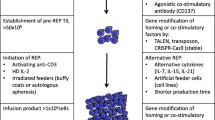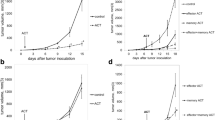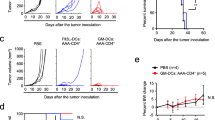Abstract
Background: Adoptive cellular immunotherapy with autologous tumor-infiltrating lymphocytes (TILs) can induce tumor regression in patients with metastatic melanoma but requires both surgical tumor harvest and successful expansion of lymphocytes in vitro. In cases in which tumors are inaccessible or TILs fail to grow, the adoptive transfer of allogeneic TILs, haplotype matched for the restriction element for a common tumor antigen, represents a possible treatment alternative. Such TILs show in vitro cross-reactivity for allogeneic tumors but have not been evaluated for in vivo activity.
Methods: An F1 hybrid mouse (C57BL/6 X DBA-2 [B6D2 F1]) was used to generate TILs (F1 TILs) expressing both H-2b and H-2d class I major histocompatibility complex (MHC) determinants, which were used to treat established autologous lung metastases in C57BL/6 (B6) parental strain mice.
Results: H-2b mice bearing the fully syngeneic MC-38 tumor were treated with F1 TILs, and a 98–100% reduction in 4-day-old established lung metastasis was achieved. However, B6 mice bearing MC-38 tumors after preimmunization with H-2d splenocytes did not show a response to F1 TILs. Preimmunization of B6 mice by intravenous injection of H-2d splenocytes at varying times before F1 TIL administration showed a dramatic reduction in F1 TIL efficacy when alloimmunization occurred as early as 2 days before therapy. Immunization against an unrelated haplotype (H-2s) sharing no MHC genes with the F1 TILs resulted in a smaller reduction of F1 TIL efficacy, possibly due to shared minor determinants.
Conclusion: Allogeneic TILs sharing an MHC restriction element for a common tumor antigen can be used to successfully treat established metastases in the nonallosensitized host.
Similar content being viewed by others
References
Rosenberg SA, Packard BS, Aebersold PM, et al. Special report. Use of tumor infiltrating lymphocytes and interleukin-2 in the immunotherapy of patients with malignant melanoma. A preliminary report.N Engl J Med 1988;319:1676.
Rosenberg SA, Yannelli JR, Yang JC, et al. Treatment of patients with metastatic melanoma with autologous tumor-infiltrating lymphocytes and Interleukin 2.J Natl Cancer Inst 1994;86:1159–66.
Crowley NJ, Slingluff CL Jr, Darrow TL, Seigler HF. Generation of human autologous melanoma-specific cytotoxic T-cells using HLA-A2 matched allogeneic melanomas.Cancer Res 1990;50:492–8.
Darrow TL, Slingluff CL Jr, Seigler HF. The role of HLA class I antigens in recognition of melanoma cells by tumor-specific cytotoxic T-lymphocytes. Evidence for shared tumor antigens.J Immunol 1989;142:3329–35.
Hom SS, Topalian SL, Simonis T, Mancini M, Rosenberg SA. Common expression of melanoma tumor-associated antigens recognized by human tumor infiltrating lymphocytes: analysis by human lymphocyte antigen recognition.J Immunother 1991;10:153–64.
Kawakami Y, Zakut R, Topalian SL, Stötter H, Rosenberg SA. Shared human melanoma antigens.J Immunol 1992;148:638–43.
Kawakami Y, Eliyahu S, Delgado C, et al. Cloning of the gene coding for a shared human melanoma antigen recognized by autologous T cells infiltrating into tumor.Proc Natl Acad Sci U S A 1994;91:3515–9.
Topalian SL, Hom SS, Kawakami Y, et al. Recognition of shared melanoma antigens by human tumor infiltrating lymphocytes.J Immunother 1992;12:203–6.
Traversari C, van der Bruggen P, Luescher IF, et al. A nonapeptide encoded by human gene MAGE-1 is recognized on HLA-A1 by cytotolytic T lymphocytes directed against tumor antigen MZ2-E.J Exp Med 1992;176:1453–7.
Van Der Bruggen P, Traversari C, Chomez P, et al. A gene encoding an antigen recognized by cytotoxic T lymphocytes on human melanoma.Science 1991;25:1643–7.
Brichard V, Van Pel A, Wölfel T, et al. The tyrosinase gene codes for an antigen recognized by autologous cytolytic T lymphocytes.J Exp Med 1993;178:489–95.
Lee TD. Distribution of HLA antigens in North American Caucasians, North American Blacks and Orientals. In: Lee J, ed.The HLA system. New York: Springer-Verlag, 1990:141–78.
Yang JC, Perry-Lalley D, Rosenberg SA. An improved method for growing murine tumor-infiltrating lymphocytes with in vivo antitumor activity.J Biol Resp Mod 1990;9:149.
Schwartzentruber DJ. In vitro predictors of clinical response in patients receiving interleukin-2-based immunotherapy.Curr Opin Oncol 1993;5:1055–8.
NIH rodents 1982 catalogue. NIH publication no. 83-606. Bethesda, MD: Department of Health and Human Services, National Institutes of Health, 1982:31,46.
Yonemoto RH, Terasaki PI. Cancer immunotherapy with HLA-compatible thoracic duct lymphocyte transplantation. A preliminary report.Cancer 1972;30:6.1438–43.
Author information
Authors and Affiliations
Rights and permissions
About this article
Cite this article
Bartels, C.J., Rosenberg, S.A. & Yang, J.C. Adoptive cellular immunotherapy of cancer in mice using allogeneic T-cells. Annals of Surgical Oncology 3, 67–73 (1996). https://doi.org/10.1007/BF02409054
Received:
Accepted:
Issue Date:
DOI: https://doi.org/10.1007/BF02409054




